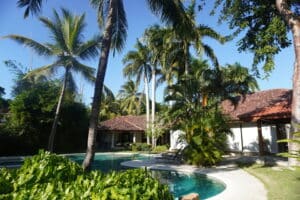Table of Contents
Introduction: Hidden Gems in the Dominican Republic
When people think of the Dominican Republic, images of all-inclusive resorts and pristine beaches often come to mind. However, this stunning Caribbean island has so much more to offer than just popular tourist spots. Let’s explore the hidden gems that showcase the island’s natural beauty, adventure, culture, and off-the-beaten-path destinations.

The Pristine Beaches of the Dominican Republic
Playa Rincon
Hidden Gems in the Dominican Republic: Tucked away on the Samaná Peninsula, Playa Rincon is considered one of the most beautiful beaches in the world. The secluded white-sand beach stretches for nearly three miles, surrounded by lush palm trees and turquoise waters. With only a few small restaurants and no large resorts, Playa Rincon offers a serene, unspoiled experience.

Playa Fronton
A true hidden gem, Playa Fronton is accessible only by boat or a challenging hike through the jungle. The stunning beach boasts dramatic limestone cliffs, crystal-clear waters, and vibrant coral reefs perfect for snorkeling.

Bahia de las Aguilas
Hidden Gems in the Dominican Republic: Located in the remote southwest corner of the Dominican Republic, Bahia de las Aguilas is a pristine, 5-mile-long beach within the Jaragua National Park. Its clear waters, abundant marine life, and untouched beauty make it a must-visit for nature lovers and beach enthusiasts alike.

Nature and Adventure
El Salto del Limon Waterfall
Hidden Gems in the Dominican Republic: Hidden deep within the jungle, El Salto del Limon is a breathtaking 130-foot waterfall. Accessible via a scenic horseback ride or hike, visitors can swim in the refreshing pool at the base of the falls, making it a perfect destination for adventure-seekers.

27 Charcos de Damajagua
Also known as the 27 Waterfalls, 27 Charcos de Damajagua is a thrilling natural water park. Visitors can jump, slide, and swim through a series of limestone pools and waterfalls, all while surrounded by lush tropical forests.

Los Haitises National Park
Hidden Gems in the Dominican Republic: This expansive park features unique karst landscapes, mangrove forests, and an extensive network of caves. Visitors can explore the park via boat or hiking trails, where they’ll encounter diverse wildlife, including endemic

species, and learn about the rich history and ecosystem of the park
Cultural Attractions
Colonial Zone in Santo Domingo
The oldest European settlement in the Americas, the Colonial Zone in Santo Domingo, is a UNESCO World Heritage site. Stroll through the cobblestone streets, explore historical landmarks, and immerse yourself in the rich history of the Dominican Republic.
La Isabela Archaeological Site
Hidden Gems in the Dominican Republic: Located on the northern coast, La Isabela was the first European settlement established by Christopher Columbus in the New World. Today, visitors can explore the archaeological site, which includes the remains of Columbus’s residence and a church, among other structures.

Taino Caves
Discover the island’s indigenous history by visiting the Taino Caves, where you’ll find ancient petroglyphs and pictographs. These caves served as ceremonial sites for the Taino people, who were the island’s original inhabitants before European colonization.

Off-the-Beaten-Path Destinations
Montecristi
This charming coastal town boasts stunning landscapes, including El Morro, a massive limestone mesa that offers breathtaking views of the surrounding area. Montecristi is also home to a national park, where visitors can explore mangroves, salt flats, and diverse wildlife.

Barahona
Hidden Gems in the Dominican Republic: Nestled between the mountains and the sea, Barahona is a hidden gem known for its ecotourism, picturesque beaches, and lush green landscapes. Explore the region’s coffee plantations, hike to hidden waterfalls, or relax on the tranquil beaches.

Samaná Peninsula
The Samaná Peninsula is a treasure trove of pristine beaches, lush forests, and hidden waterfalls. Visitors can also witness the annual humpback whale migration, explore the vibrant town of Las Terrenas, or relax on the secluded beaches of Playa Rincon and Playa Fronton.

Tips for Exploring Hidden Gems
When exploring these hidden gems, it’s essential to respect the environment and local communities. Travel responsibly, leave no trace, and consider hiring local guides to enhance your experience and support the local economy.
Conclusion
Hidden Gems in the Dominican Republic: The Dominican Republic’s hidden gems reveal a side of the island that extends beyond its renowned all-inclusive resorts. From unspoiled beaches to captivating cultural attractions and off-the-beaten-path destinations, these gems offer visitors an authentic, unforgettable experience.
Frequently Asked Questions (FAQs)
1. What is the best time to visit the Dominican Republic?
Hidden Gems in the Dominican Republic: The Dominican Republic is a year-round destination. However, the best time to visit is generally between December and April, when the weather is cooler and drier.
2. Do I need a visa to visit the Dominican Republic?
Visitors from many countries, including the United States, Canada, and the European Union, do not require a visa for tourist visits up to 30 days. Check with your local embassy for the latest entry requirements.
3. Is it safe to travel to the Dominican Republic?
The Dominican Republic is generally considered safe for tourists. However, as with any destination, it’s essential to exercise caution and stay informed about local conditions.
4. What currency is used in the Dominican Republic?
The Dominican Peso (DOP) is the official currency. US dollars are widely accepted in tourist areas, but it’s a good idea to have local currency on hand for smaller establishments and off-the-beaten-path destinations.
5. Can I drink the tap water in the Dominican Republic?
It’s not recommended to drink tap water in the Dominican Republic. Opt for bottled or purified water instead.





